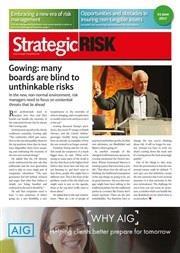The risk management profession must evolve quickly in order to meet the challenges of tomorrow and demonstrate the growing strategic value risk managers bring to their organisations, study finds

According to Airmic deputy chief executive and technical director Julia Graham, risk management is a profession undergoing “unprecedented transformation”.
The emergence of new technologies and business models, coupled with the rising prominence of intangible risks such as reputation, data and intellectual property, has created a need to update traditional approaches to quantifying, managing and transferring risk, she says.
Graham’s comments feature in a wide-ranging report by Airmic (alongside sponsors AXA Corporate Solutions, Chubb and JLT and research partner Longitude), entitled A Profession in Transformation, which surveyed 152 risk managers to identify the challenges and changes in store for tomorrow’s risk leaders.
Just under three quarters of respondents said the profession must undergo significant change to keep pace with the fast changing business environment. “The whole context of the world in which our members are working is like quicksand,” Graham says. “The complexity, pace and need for transparency in the environments in which they operate are breath-taking.”
Airmic identifies three key disruptive factors influencing the risk landscape: the unprecedented speed of change; the growing complexity of risk, business models and technology dependence; and increased transparency - planned or otherwise - thanks in part to the rise of social media.
“An additional challenge for risk managers is that many of the most significant threats they face are interconnected, making them harder to manage and giving them greater scope to cause harm,” it says.
Complexity and interconnectivity
“The way we do business has been so revolutionised by technology that the nature of our assets, objectives and risks have fundamentally changed. This requires new skills, investment and an open mind,” explains John Ludlow, chief executive of Airmic.
“We must understand how to manage and measure the new assets, to identify and understand the new risks and develop ways of adding new value,” he says, adding: “It can be hard to invest and change when the market is under pressure; however, the rewards for the brave are greatest.”
According to the survey, loss of reputation/brand value, cyberrelated business interruption risks, and market developments such as competition, M&A and market stagnation, are the concerns at the top of risk managers’ minds in the new environment. “Reputation is now the biggest intangible asset on the balance sheet of most organisations,” Airmic says.
Risks to other intangible assets, such as data, are also a key concern. “Familiar threats remain on the risk radar – they are just further down the list of priorities,” the report notes.
Meanwhile, around a quarter of respondents identified the emergence of new business models arising from disruptive technologies such as artificial intelligence and the internet of things as an area of increasing concern. Just 20% of risk managers are confident or very confident about addressing the risks attached to artificial intelligence applications, while just 18% feel that way about virtual reality.
One of the biggest challenges is that many of these complex or intangible risks are interconnected. Damage to reputational equity, for example, is an all-pervading risk that can be triggered by a number of interconnected risks. Yet according to Airmic, many organisations continue to think of risk in silos.
Airmic argues that greater collaboration and closer partnerships are needed with technology, information security and other departments. While 66% of respondents have regular, close collaboration with finance, only 32% have this with the technology department, 30% with strategy and 21% with HR employee benefits - though relationships in these areas are predicted to improve.
Risk managers’ relationships with insurers are also set to change. While insurers are developing new products to help tackle some of today’s emerging risks - particularly cyber risk - many intangible risks remain virtually impossible to transfer to the insurance market. Only 3% of respondents, for example, said they expect to be able to insure reputational risk.
Insurers are, therefore, increasingly expected to provide value-added services to help risk managers deal with the new environment, and going forward a more collaborative, partnership-type approach is likely to be adopted, Airmic says.
Role in transition
Against this backdrop, risk is moving higher up the boardroom agenda and the role of risk managers is becoming more strategic, with 82% of respondents expecting the value created by risk management to increase and for it to become a more regular topic in board meetings over the next three years.
“Today’s risk managers increasingly operate as business enablers, working strategically with executive management to ensure that the business can exploit opportunities for growth,” Airmic explains, adding: “Risk managers do not believe their role is to highlight the roadblocks standing in the way of such opportunities, but rather to find the most effective routes around them.”
However, challenges remain around the perception of risk management. Nearly half of respondents (47%) currently struggle to articulate the value of their profession, which is still too often seen as focused on risk prevention rather than enabling growth.
“Risk and insurance managers need to be the conduit that takes insurance and risk transfer information from the market and translates it into what it means for the business, its balance sheet and its future growth and success,” says Adrian Donald, partner at JLT Specialty, who adds that speaking the language of the C-suite rather than insurance-speak is one way risk managers can better demonstrate their value.
Nevertheless, progress is being made by risk managers, particularly when it comes to embedding resilience within their organisations.
Going forward, data is likely to play a key role in improving all aspects of risk management as a strategic tool. Airmic notes that while 35% of respondents say their use of analytics today is limited, 56% expect to use analytics extensively within three years.
“Risk managers of tomorrow will look very different from their counterparts of today,” Airmic says. “They will need a broader range of skills and competences – and are therefore likely to come from a more diverse range of backgrounds. Their roles will be more varied and increasingly strategic.”
Airmic’s A Profession in Transformation study also includes a three-part report series that digs deeper into how the risk management profession is responding to the fast-evolving business environment:
● Is the insurance market fit for the future? In today’s interconnected world, reputation and brand value can be damaged in seconds. Many of today’s biggest risks are intangible and virtually impossible to transfer to the insurance market. This report, supported by AXA Corporate Solutions, explores how risk management is becoming more strategic in the interconnected risk landscape, and finds that, in addition to broadening their suite of cyber products, insurers are offering value-added services and adopting a partnership approach to help risk managers adapt to the challenges of tomorrow.
● Digital transformation. Airmic, in collaboration with Chubb, here considers how digitalisation and emergent technology is disrupting and transforming business models while creating strategic opportunities for members. According to the report, risk managers face a steep learning curve. They must work more closely with colleagues in their tech departments, encourage management to see cyber risk as an enterprise risk and work to implement clear cyber governance frameworks, it says.
● The value of risk and insurance management. While most risk managers feel their work is bringing more value to their organisations, few are able to effectively articulate the strategic benefits of risk and insurance to internal and external stakeholders. Airmic and partner JLT argue that by speaking relevant language and raising awareness of insurance across the corporate ranks, risk managers can demonstrate that they offer more than just transactional cost saving - they help their organisations meet their corporate goals while also safeguarding the balance sheet.
Airmic’s 10 takeaways for risk managers
1. Develop techniques for assessing intangible, complex and connected risks which go beyond silos.
2. Improve skills in communication, relationship building and conflict resolution.
3. Improve knowledge, such as in technology, finance and business acumen.
4. Learn to create, analyse and exploit relevant data more effectively
5. Establish ways of working to ensure networks develop, teaming occurs and productivity is heightened.
6. Understand their skills and experience gaps, and create personal development plans
7. Form stronger profiles and relationships with their executive order to drive enterprise risk management.
8. Build closer and more collaborate partnerships with functions across their business.
9. Align insurance to financial metrics such as operating profit and earnings to attract board attention and increase the value of insurance.
10. Work more closely with insurers and brokers to articulate what innovative solutions are needed.




















No comments yet